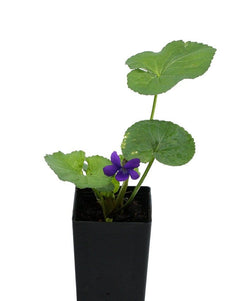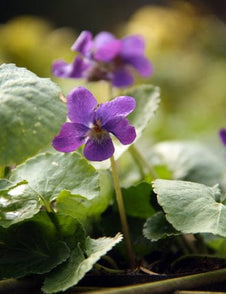







Sweet Violet
Sweet Violet

- In stock, ready to ship
- Inventory on the way

Usually available: April to November
Life cycle: Perennial
Height: 10 - 15cm
Position: Part shade
Soil preference: Well drained
This is how we pack and send your Herb Plants to all states except TAS & WA
You will receive
- 1 Sweet Violet Herb Plant in a 50 X 75mm tube - General growing instructions
All of our Herb Plants are grown organically with certified organic potting mixes and fertilizers
Botanical Name: Viola odorata
Sweet Violet is a small, herbaceous perennial which may reach a height of 10-12cm and spread 12-60 cm. The mid to dark green leaves are small, broadly ovate and held in rosettes. The sweet scented, deep purple flowers are also held in rosettes and appear from autumn to early spring. The plants spreads using stolons and it is often found near forest edges and clearings where it can receive some sunlight.
Sweet Violet is native to Europe, Northern Africa, and Asia but is cultivated extensively throughout the world. The scientific name for this plant is Viola odorata and it belongs to the Violaceae family. It may also be known as Wood Violet, English Violet and Common Violet. From ancient times Violets were used to make wines, eaten in desserts and salads and used to make cosmetics. Sweet Violet also has a long history of traditional medical use, however today it is mostly grown as an ornamental plant and has many cultivars.
Growing Conditions
Sweet Violet prefers to grow in rich, moist and shaded locations. All soil types are acceptable, but free draining sandy or light soils are preferred and will give ideal results. Open areas under trees are ideal, where they may receive dappled shade and sunlight, but be protected from direct summer heat. Although violets grow well in shade as a ground cover, they often require sunlight to flower well. If possible, plant Sweet Violet where the plants will receive morning sunlight, perhaps under deciduous trees. Full sun will encourage heavy flowering from autumn to spring. Sweet Violet is most often grown from seed or by separating the small plants from the parent plant.
Medicinal Uses
Sweet Violet has a long history of traditional medicine use for internal and external applications. Some of the conditions it was used for by Ancient Greeks included insomnia, epilepsy, ailments of the female reproductive tract, jaundice, urinary and kidney problems and to strengthen the heart. It was also thought to be useful for treating swellings, bruises, piles and inflammations.
Modern medical research has discovered that Viola odorata does contain salicylic acid, the active component of aspirin. The leaves are also known to contain soothing mucilage and have antiseptic properties and the flowers are known to be slightly laxative, while the seeds are diuretic. Overall, there are numerous potential applications for medical or herbal use of Sweet Violet that support its use in the early practices of herbal medicine. The leaves can be made into a tea or syrup and used for various applications, including colds and coughs, poultices for skin problems and as a general strengthening tonic.
Culinary Uses
The flowers of Sweet Violet are edible and may be added to vinegars, used as crystallised candies, or added to jellies, juices, are infused to create wines. The flowers have also been used to make eye make-up and fragrant hand or face creams.
All information provided on this website is for informational purposes only. Please seek professional advice before commencing any treatment.





